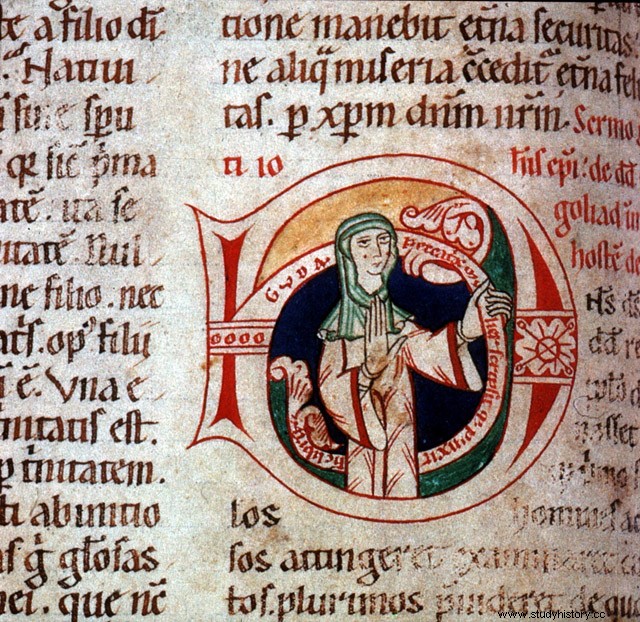German illuminator of the XII e century, Guda left an imprint on history, notably by creating one of the oldest female self-portraits in the history of Western art.
Copies and illuminators

In the Middle Ages, within the monasteries, copyists and illuminators worked in the scriptorium, copying and illustrating religious texts or works from Antiquity. The monasteries are then places of knowledge and dissemination of culture; abbesses often came from noble families, continued their studies after taking the veil and worked to train novices. Some write their own texts, like Hildegarde de Bingen who composes liturgical songs and works of theology, or like Herrade de Landsberg. In the XII th century, she compiled the first encyclopedia produced by a woman, the Hortus Deliciarum , which deals with theology, history, geography, astronomy, mythology, and which aims to instruct novices.
Beyond these illustrious examples, female names among medieval copyists and illuminators are rare. Many of their manuscript books, which are all works of art, are indeed unsigned; failing that, they are then frequently attributed to men. Before the XII th century, less than 1% of manuscript works are signed with a woman's name. Even in female monasteries, less than 15% of manuscripts can be attributed to a woman. However, many women's monasteries have a scriptorium. In the IX th century, the Abbess of Chelles made a dozen nuns work on a Commentary on the Psalms of Augustine in three volumes. In Germany, a study published in January 2019 shows, thanks to the traces of blue pigment on the teeth of a nun who died nearly 1,000 years ago, its role in the production of illuminations. A study that suggests that female copyists and illuminators were more numerous than recognized.
“Guda, sinner”
Around the middle of the twelfth th century, Guda is a nun in a monastery in the Middle Rhine. She exercised her talents as a copyist and illuminator there. It illustrates in particular the homily (a collection of homilies, comments pronounced during the mass) said of Saint-Barthélemy, preserved in Frankfurt since the XV th century.
Guda is represented in the manuscript, inside a drop cap introducing the chapter on the feast of Pentecost. Her right hand raised as if in a gesture of testimony, she paints herself in a nun's habit, holding a headband in which the following words are written:“Guda, peccatrix mulier, scripsit et pinxit hunc librum” (Guda, sinner, wrote and illuminated this book). This signature, in the form of a claim for long, complex and meticulous work, shows that Guda is aware of the value of his art. At the same time as her work, she thus signed one of the first female self-portraits in the history of Western art.
